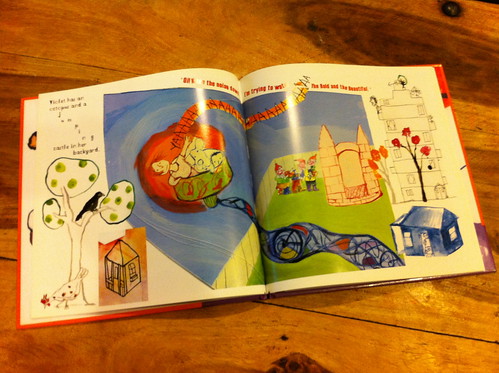This week I will lead the reading group discussion. The task is to:
·
Facilitate the discussion about the pre workshop
tasks that are described on the website.
·
Post the summary of the key discussion points and
any issue raised on the blog. Other group members will then make a response.
Katina
chose to do the workshop tasks on 2 Weeks with the Queen by Morris Gleitzman.
For her story shape she used the standard narrative presentation. 2 weeks with
the Queen utilises Brooker’s plot of tragedy as it is presumed that the brother
dies at the end of the story.
Katina’s
other workshop task revolved around the ‘Three little Pigs’. For her story shape
she used the home and away and said that the plot which the book fits best was
overcoming the monster; which in this case was the wolf.
Alicia
chose to do the workshop tasks based on Potato People by Pamela Allen. For her
story shape she used the standard narrative presentation. Alicia said that
Potato People fitted Brooker’s comedy plot as there was uncertainty as they
were shut off from each other until the situation was resolved and more potato
people were made. Potato People used narrative techniques such as imagery and written
in 3rd person.
In
Flander’s Field was the other book Alicia used for her pre workshop task. For
her story shape she used the home away home and stated that the best of Brooker’s
7 plots that fitted ‘In Flander’s Field’ was quest because the hero goes on a
journey to help free the bird, when he arrives to the bird there is frustration
as the bird cannot fly, the soldier holds the bird to his heart and the bird
flies away. When the soldier returns ‘silent night’ is sung and shows that even
in the dark human spirit can bring light and life. The narrative techniques for
this book are similar to Potato People as it is written in 3rd
person and imagery/ symbolism is important.
Sarah
chose Jillaroo by Rachel Treasure to complete her pre workshop tasks. For her
story shape Sarah used the home away home approach as the main character leaves
and then whilst away realises that home is important and returns. Jillaroo uses
a combination of voyage & return but also tragedy as the brother commits
suicide, so there is no real linear plot. The narrative techniques used in
Jillaroo are conflict (character vs character) and imagery.
My Sister’s
Keeper was the other novel Sarah chose to do her pre workshop tasks. She used
the narrative standard presentation for her story shape as she said it didn’t really
fit the others. The Brooker’s plots which best fits my sister’s keeper were interchangeable
(quest, overcoming the monster and tragedy). The novel was written in 1st
person and reflected on the main characters and what and how they were feeling.
I chose
to do the pre workshop tasks on The Lorax by Dr Suess and The Pocket Dogs by
Margaret Wild and Stephen Michael King.
The
Pocket Dogs didn’t really fit any of the story shapes so I used the narrative
standard presentation.
Setting –
metropolitan city, home, park
Action
leading to climax – pocket dogs go shopping in pocket
Climax –
pocket breaks, dog is lost and left at shop
Solution –
Mr Pocket comes back
Conclusion
– dog is returned with owner
Brooker’s
plot of voyage and return best fits The Pocket Dogs as the dog gets lost and
meets new people. The book features narrative techniques such as alliteration,
anthropomorphism and repetition.
The Lorax
by Dr Suess was the other book I used to complete the pre-workshop tasks. Again
I felt that none of the story shapes fitted the book so I used the standard
narrative presentation.
Setting – at the far end of town, where the grackle
grass grows
Action
leading to climax – cutting down of truffula trees (greed)
Climax – the
environment is being ruined by greed
Solution –
all trees are gone and so is the Lorax (chance for a restart?)
Conclusion
– once-ler throws the last seed to the boy and asks him to take care of it
Brooker’s
plot of overcoming the monster and rebirth fit ‘The Lorax’ best overcoming the
monster is the greed of those cutting down the Truffula trees and rebirth is
when the once-ler gives the boy the last seed.The Lorax
uses a range of narrative techniques including alliteration, rhyme and rhythm.
Ruth was
absent for this workshop.
In the
workshop we were given a chapter from Emily Rodda’s 1993 novel Rowan of Rin and
asked to change the story to another character’s perspective – we chose to re
tell the story from the Dragon’s perspective.
Here is what we came up with:
The
dragon watched the terrified boy quiver and let out a pitiful scream. He kept
the other human in place with his massive tail and growled menacingly – he couldn’t
deal with intruders today, not with the unbearable pain searing through his
jaws.















